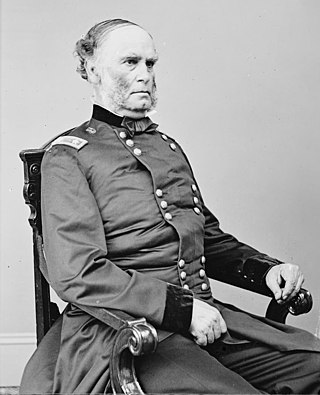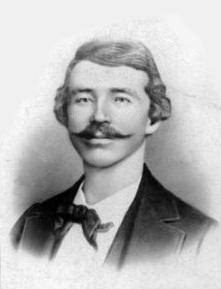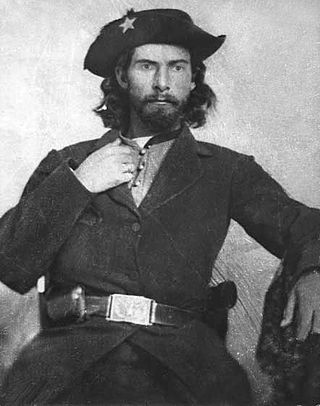
Lake Lotawana is a city in Jackson County, Missouri, United States and is located 35 miles southeast of downtown Kansas City bordering Blue Springs and Lee’s Summit. The population was 2,310 as of the 2020 census. It is part of the Kansas City metropolitan area.

Samuel Ryan Curtis was an American military officer and one of the first Republicans elected to Congress. He was most famous for his role as a Union Army general in the Trans-Mississippi Theater of the American Civil War, especially for his victories at the Battles of Pea Ridge in 1862 and Westport in 1864.

Quantrill's Raiders were the best-known of the pro-Confederate partisan guerrillas who fought in the American Civil War. Their leader was William Quantrill and they included Jesse James and his brother Frank.

William Clarke Quantrill was a Confederate guerrilla leader during the American Civil War.

The Battle of Baxter Springs, more commonly known as the Baxter Springs Massacre, was a minor battle of the American Civil War fought on October 6, 1863, near the present-day town of Baxter Springs, Kansas.

The Lawrence Massacre was an attack during the American Civil War (1861–65) by Quantrill's Raiders, a Confederate guerrilla group led by William Quantrill, on the Unionist town of Lawrence, Kansas, killing around 150 men and boys.

William T. Anderson, known by the nickname "Bloody Bill" Anderson, was a soldier who was one of the deadliest and most notorious Confederate guerrilla leaders in the American Civil War. Anderson led a band of volunteer partisan raiders who targeted Union loyalists and federal soldiers in the states of Missouri and Kansas.

The First Battle of Independence was a minor engagement of the American Civil War, occurring on August 11, 1862, in the city of Independence, located in Jackson County, Missouri. Its result was a Confederate victory, continuing the Southern domination of the Jackson County area for a few days while the recruiters completed their work.

The Battle of Lone Jack took place during the American Civil War on August 15–16, 1862 in Jackson County, Missouri. The battle was part of the Confederate guerrilla and recruiting campaign in Missouri in 1862.

Thomas Coleman Younger was an American Confederate guerrilla during the American Civil War and later an outlaw leader with the James–Younger Gang. He was the elder brother of Jim, John and Bob Younger, who were also members of the gang.

James G.Blunt was an American physician and abolitionist who rose to the rank of major general in the Union Army during the American Civil War. He was defeated by Quantrill's Raiders at the Battle of Baxter Springs in Kansas in 1863, but is considered to have served well the next year as a division commander during Price's Raid in Missouri.

Bushwhacking was a form of guerrilla warfare common during the American Revolutionary War, War of 1812, American Civil War and other conflicts in which there were large areas of contested land and few governmental resources to control these tracts. This was particularly prevalent in rural areas during the Civil War where there were sharp divisions between those favoring the Union and Confederacy in the conflict. The perpetrators of the attacks were called bushwhackers. The term "bushwhacking" is still in use today to describe ambushes done with the aim of attrition.
The trans-Mississippi theater of the American Civil War was the scene of the major military operations west of the Mississippi River. The area is often thought of as excluding the states and territories bordering the Pacific Ocean, which formed the Pacific coast theater of the American Civil War (1861–1865).

At the outbreak of the American Civil War in April 1861, Kansas was the newest U.S. state, admitted just months earlier in January. The state had formally rejected slavery by popular vote and vowed to fight on the side of the Union, though ideological divisions with neighboring Missouri, a slave state, had led to violent conflict in previous years and persisted for the duration of the war.
The sacking of Osceola was a Kansas Jayhawker initiative on September 23, 1861, to push out pro-slavery Southerners at Osceola, Missouri. It was not authorized by Union military authorities but was the work of an informal group of anti-slavery Kansas "Jayhawkers". The town of 2,077 people was plundered and burned to the ground, 200 slaves were freed and nine local citizens were court-martialed and executed.

George M. Todd was an American Confederate guerrilla leader during the American Civil War who served under William C. Quantrill. A participant in numerous raids, including the Lawrence Massacre in 1863, he was ultimately killed at the Battle of Little Blue River in 1864.
James J. Chiles, also known as Jim Crow Chiles, was a Confederate outlaw who fought with Quantrill's Raiders.

Kansas Raiders is a 1950 American Western film directed by Ray Enright, and stars Audie Murphy, Brian Donlevy, Marguerite Chapman, and Scott Brady. It is set during the American Civil War and involves Jesse James coming under the influence of William Quantrill.
Sni-A-Bar Township is an inactive township in Jackson County, in the U.S. state of Missouri. It was annexed into the city of Kansas City, Missouri and is within the Kansas City metropolitan area.
The skirmish near Brooklyn, Kansas was a skirmish of the American Civil War on August 21, 1863, between Quantrill's Raiders and pursuing Union forces immediately after the Lawrence massacre. James Henry Lane led a small group of survivors of the massacre in pursuit of Quantrill's men, and were joined by a force of about 200 Union Army cavalrymen, commanded by Major Preston B. Plumb. Lane's and Plumb's men fought with Quantrill's Raiders to the south of the town of Brooklyn, Kansas, which the raiders had burned. The Confederates began to panic, but a charge led by George Todd halted the Union pursuit. Quantrill's men escaped across the state line into Missouri and then scattered; a few were later caught and executed.













